After a while, nothing seems strange in a stadium with a
"lid"
from Smithsonian, January, 1988
by Claude Charlier
Photographs by Gerd Ludwig
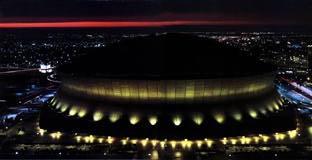
Sun seldom sets on an idle Superdome, a marvel of engineering that has
transformed its one-seed New Orleans neighborhood into a prosperous
mecca. At night, stadium glows like a visitor from anotherplanet.
On the afternoon of January 3, l962, seven armed men in cowboy hats met
on the outskirts of Houston. The site was dismal, known for damp summers
and mosquitoes the size of turkey buzzards. At the appointed hour, the
men took their Colt .45s, fired them into the earth and thus broke ground
for a stadium to house the city's new baseball franchise, a team then
known as the Colt .45s and now called the Astros. The men were also
breaking ground-or so many Houstonians
were ready to argue-for a new millennium in American sports. The building
they were about to put up was no mere ballpark but an indoor sports
theater, a palace even, with upholstered seats, air-conditioning and a
Louis XIV bedroom in a VIP suite, all under a steel dome spanning 642
feet. "This is going to be the sports showplace of the nation," said
Judge Roy Hofheinz, president of the Houston Sports Association. "Others
will follow us. Ballplayers will be dying to play in our stadium." In
truth, Casey Stengel, the garrulous manager of the New York Yankees, took
one look at it before an exhibition game a few years later and declared,
"This here's the kind of building where from the outside you can't tell
where first base is." Batters learned to dread the Astrodome, which
became known as the "doom dome" because so many hard-hit balls seemed
mysteriously to fall short. But Hofheinz spoke wisely when he said other
cities would follow. It wasn't long before folks over in New Orleans were
declaring their intention to make the Astrodome look like "a peanut
stand," and in time the city's colossal Superdome-a squat, cooling tower
of a building wrapped in a metallic corset-did take over as one of the
sports showplaces of the nation, even without a baseball team. Since
the Astrodome opened in 1965, 15 enclosed stadiums have gone up under
roofs of steel, wood or, most often, fabric. The newest dome, in St.
Petersburg, Florida, is due for completion in 1989-a grand gesture of
civic optimism, since there is no guarantee that a professional baseball
or football team will start up there anytime soon. A handful of other
cities (Phoenix, Atlanta, Orlando and San Antonio) now have domes planned
or proposed.
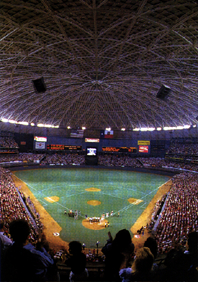 Interior photgraph of fans and dome by -- F. Calter Smith.
Interior photgraph of fans and dome by -- F. Calter Smith.
caption: Houston fans watch baseball game
in air-conditioned comfort at the Astrodome,
which opened in 1965.
Circus tents and ridged potato chips
Or rather, what they have on their drawing boards are buildings
called domes. In classical architecture, as with St. Paul's
Cathedral in London, a dome wasn't a dome unless it had a roughly
hemispherical shape. But that ceased to be true with the Astrodome's
first imitator, the Idaho State University Minidome, a stadium in
Pocatello shaped like a Quonset hut (students called it the
"half-Astrodome"). The word "dome" has since come to describe any place
big enough to accommodate baseball or football-but with a lid. In some of
the latest schemes, the lids resemble circus tents, saddles, ridged
potato chips. These domes have been labeled modern-day cathedrals,
civic icons, the symbols by which cities declare their status as
world-class players. They have changed not just the architecture but also
the economics of urban life. They have certainly reshaped American
sports-notably at the last World Series, in which, some people asserted,
the Minneapolis Metrodome should have been named the Most Valuable
Player. Domes have become forums for religion and politics as well. When
Pope John Paul II visited New Orleans last year, 55,564 people heard him
speak at the Superdome (where another 27,561 people watched Tulane
University play football that evening). And when the Republicans nominate
a Presidential candidate at the Superdome this summer, theirs will be the
first, but surely not the last, dome convention. After a little more than
a quarter-century, we are knee-deep in what one sports trade journal
terms the "dome age."
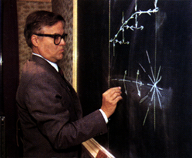 David Geiger, designer of the Hoosier Dome
David Geiger, designer of the Hoosier Dome
and other innovative stadiums, illustrates the
principles of "tensegrity" concept on blackboard.
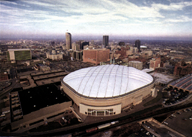 The Hoosier Dome
The Hoosier Dome
Judge Hofheinz, a self-described huckster with slicked-back hair and
heavy black-framed eyeglasses, liked to say that it all began with a
visit to the Colosseum in Rome. A guide there told him that when the
weather turned nasty, slaves would pull a velarium, or awning, across the
ancient stadium; the idea took hold in his imagination, bearing fruit in
the form of the Astrodome. Actually, the dome idea was around before
Hofheinz ever went to Rome. In 1955, the Brooklyn (now Los Angeles)
Dodgers had commissioned architect and geometrician R. Buckminster Fuller
to design a domed replacement for Ebbets Field. Fuller had also drawn up
a similar dome for the Tokyo Giants. But no stadium ever used Fuller's
geodesic scheme, which was deemed uneconomical. Indeed, cost was the main
reason that, after the Astrodome, only two major domed stadiums went up
under any kind of rigid roof: the Superdome, which used a steel
framework, and the Kingdome in Seattle, which was built with cement.
What really got the dome boom going was an outlandish entry in the
architectural competition for the U.S. exhibition hall at Expo '70 in
Osaka, Japan. Davis-Brody, a New York firm, designed a sort of pumpkin on
top of an inverted pyramid, together 30 stories high. The pumpkin was to
be built of fabric and held up by air, a type of structure that until
then had been used to house only tennis courts and military radar
installations. The architects scouted around for an engineer who could
flesh out the design concept and they wound up with David Geiger, then a
young adjunct professor at Columbia University. The design won, but
Geiger found himself stuck with a site that was prone to earthquakes and
150 mile-an-hour typhoons. Then Congress came up with less than half the
expected budget. In desperation, the design team took a vertical cross
section of the pumpkin and laid it flat on the ground, preserving the
blocky, superelliptical outline-and very little else-from the original
plan. The result was almost a nonbuilding. It consisted of an earthen
berm topped by a concrete ring and enclosed two and a half acres under a
vast fabric lid. But it set the pattern for most of the domed stadiums
built since then. A system of fans held up the fabric roof by boosting
air pressure inside. A web of cables thrown over the top secured the
fabric and divided it into pillowy sections. Figuring out the cable
pattern was the hardest thing, even with the help of an advanced
computer. Geiger found that a standard grid, with cables crossing at
right angles, caused the roof to sag at the perimeter. But one Saturday,
in a moment of inspiration, he realized he could eliminate the problem by
running the cables diagonally. This "skewed symmetry" still characterizes
almost all such roofs.
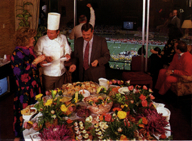 Chef greets guests in Superdome suite while
Chef greets guests in Superdome suite while
Louisiana State University plays Nebraska in
1986 Sugar Bowl.
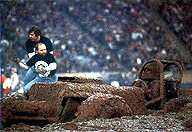 During Hoosier Dome event called National Mud
During Hoosier Dome event called National Mud
and Truck Pull, officials watch vehicle churn
in slime.
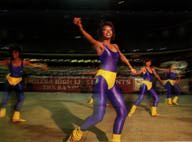 Dancers entertain crowd during a halftime
Dancers entertain crowd during a halftime
contest between bands of college teams playing
in Superdome.
The Hoosier Dome in downtown Indianapolis
is one of eight air-supported domes in this country that Geiger went on
to engineer after the triumph at Osaka. Visiting it, you get a sense of
both the magical simplicity and the underlying complexity of the design.
On this particular evening, the dome floor has become a fairground with
amusement park rides for families attending a national convention of
county officials. Politicians with their feet up ride three abreast down
a long slide, while their children turn shades of pale on the
Tilt-A-Whirl.
A support column that's made of air
The space is so vast that it's possible to forget you are indoors, much
less tilting and whirling headon into an architectural support column-a
continuous column of air maintained at a pressure slightly higher than
the pressure outside. You tend to notice only at the emergency doors or
at the hatchway onto the roof, where the air pressure suddenly turns into
a 35-mile-an-hour wind at your back.
George Shopp, dome-bellied and with his pockets full of keys, small
clipboards, a two-way radio, a beeper and other paraphernalia, stands on
the roof he is charged with keeping airborne and describes some of the
little headaches of the job. If the upper-level lavatories go unused for
a week, for instance, the unrelieved air pressure will blow the water out
of the traps, pushing enough warm air out of the plumbing vents to heat
about two houses through a Midwestern winter. And when the National
Football League Colts (lured here from Baltimore by the dome in 1984) are
in a close game, Shopp has to figure out how much to tweak up the air
pressure through the fourth quarter. He does this in anticipation of
60,000 fans suddenly exiting through 24 wide-open doors. If the pressure
goes too high, they might hurtle out; if it's too low, the dome could sag
several feet.
When the midwinter skies dump six inches of wet snow in an hour, Shopp
has to calculate how much pressure he needs to support the extra weight
and how fast to get the snow melted. A heavy hand on the snowmelt switch
can cost $250,000 because it means the Hoosier Dome will have to pay the
surge rate for electricity during the next year. Some stadiums send crews
onto the roof with fire hoses and shovels or, if the snow is dry, simply
tauten the Teflon-coated fiberglass to let the wind blow it clean. But
rivalrous feelings in the dome game extend even to maintenance, and Shopp
disdains these foreign methods as stressful to the fabric. Whereas the
control rooms at conventional stadiums devote their fancy electronics to
lighting, scoreboards and instant replay television, the possibility of
deflation gives the roof priority at the Hoosier Dome.
 Guard checks fabric roof of Silverdome in Pontiac,
Guard checks fabric roof of Silverdome in Pontiac,
Michigan. Electric fans boost air pressure for support.
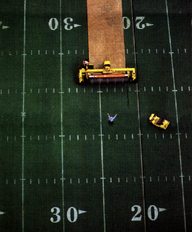 "Grasshopper" rolls up artificial turf in Superdome.
"Grasshopper" rolls up artificial turf in Superdome.
It takes four or five hours to remove an entire field.
Gauges monitor wind speed on two sides, roof height (which varies from
188 feet to 193 feet at the center), air pressure, temperature and
humidity. There are switches to control 20 six-foot-high turbine fans (it
takes only two to keep the roof up, unless the doors are open) and an
eight-zone snowmelt system. The awful possibilities make for interesting
work. "If you assume you know what you're doing on this," Shopp says,
"about that time it's gonna getcha."
Deflations, while bad, aren't usually all that bad because the roof will
hang up over the spectator area even when bellied down. But when the
Silverdome in Pontiac, Michigan, deflated under heavy snow in March 1985,
the fabric tore on some lighting framework and high winds whipped it like
a sheet on a clothesline. A weather radar system now watches over the new
roof, whlch cost $10 miIlion. At the Metrodome in Minneapolis, a 1986
incident led to a partial evacuation during a Twins game attended by
32,000 people. When wind shear hit one side of the roof, the control
system registered it as a surge in the building's air pressure and,
instead of tautening the roof against the wind, automatically began
dumping air to compensate. The 10,000-pound light banks and the
ceiling-hung speakers started to sway, and plugs in the roof popped,
pouring water down the third-base line. Spectators on the upper decks had
to evacuate, using revolving doors to avoid further loss of pressure.
Some people panicked and there were minor injuries. After nine minutes,
the roof stabilized and the game resumed. But such incidents are one
reason why engineers have developed new ways to put up domes.
The trend toward retractability
Perhaps the most ambitious, the Toronto Skydome will open next year under
a complicated steel roof said to be retractable in just 20 minutes. Local
boosters are already hyping it as the "world's first convertible with
60,000 bucket seats," and Toronto architect Rod Robbie happily asserts
that his roof will make "what Geiger does obsolete." It won't be a true
dome, but an assemblage of curved sections that can separate, so that
some can pull back from above the playing field and telescope inside the
others, leaving 90 percent of the stadium open. In this respect, it will
outdo the partly retractable fabric cover recently added to Montreal's
Olympic Stadium. Skydome officials say that the roof will cost them $53
million, and they have lately upped their estimate for the entire stadium
to $178 million.
Retractable roofs have always been the dream, going back to Hofheinz's
notion of the Roman velarium; they combine freedom from rainouts with the
promise of "baseball like it ought to be"-in the sun. But rivals tend to
dismiss the Toronto facility as a pie-in-the-skydome. "You spend all that
money for air-conditioning and then you spend all that money to open it
up again," says an Astrodome executive. "What for? A nice day? What's
nicer than having a nice air-conditioned building? You must have a lot of
money to do something that foolish."
David Geiger also nurses rivalrous doubts. He argues that if you take a
lot of concrete (and dome tour guides are inexplicably proud of their
concrete-at the Hoosier Dome, for instance, they mention a 36mile-long,
two-lane highway's worth), bake it in the sun for a few hours, then snap
the roof shut to fend off a sudden rain, you are liable to cook a few
fans. On the other hand, even ordinary domed stadiums can blow $10,000 a
day on heat when they wheel in steel grandstands from a cold warehouse.
"It's like putting a big ice cube in your bathtub," says Bob Haney, the
operations director at the Silverdome.
"Bucky fell in love with triangles"
For the St. Petersburg stadium, Geiger has veered off in an entirely
different direction. It will have a nonretractable fabric roof held up by
cables rather than by air. He says he was inspired this time by the
economics of litigation. Having been sued in connection with several
deflations, he wanted to come up with a dome that would be as cheap as
his air-supported structures but without wagering his future on good
weather and the diligence of maintenance crews. He thought back to
Buckminster Fuller's domes. "Bucky fell in love with triangles," says
Geiger, now 52, with wavy, disheveled gray hair and wearing
tortoise-shell bifocals. "He made his fame with the geodesic dome, which
was essentially triangulating the surface of the sphere." But Fuller also
had another concept, the "tensegrity" dome, which never got off the
drawing board. His geodesic domes were built of rigid structural elements
under compression; the tensegrity dome would depend largely on structural
elements under tension. In a sense, it's the difference between an igloo
(compression) and a tent (tension). Geiger developed a modified
tensegrity configuration for St. Petersburg's dome. All the cables pass
through a single point at the center of the roof. These cables are
supported at intervals by vertical posts, which in turn stand in midair
on a system of four concentric cable hoops. Other cables, running
diagonally, hold posts and hoops in place, under tension. The roof will
weigh two to four pounds per square foot, versus one pound for an
air-supported roof and 30 to 40 pounds for a steel roof, and it is
designed to stand up to weather without special care.
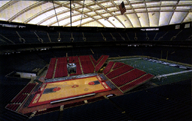 Detroit Lions go through an afternoon practice in
Detroit Lions go through an afternoon practice in
part of Silverdome still surfaced for football.
The arena for basketball has already been set up
to accommadate a Pistons contest scheduled that
evening.
Ask anybody what effect these domes have had on American life and you
will probably get the one-word answer, "AstroTurf." It is now almost
folklore that the Astrodome's 4,596 skylights produced blinding glare for
players fielding pop flies, that using an orange baseball didn't help and
that, in the end, painting the skylights killed not just the glare but
the natural grass on the playing field. The solution was a synthetic
grass substitute, promptly dubbed AstroTurf.
If AstroTurf were the only effect the domes have had, it would be pretty
small potatoes, especially considering the hoopla that has attended their
coming. When civic leaders elsewhere talk about the benefits of a domed
stadium, they invariably cite the example of New Orleans: no longer a
backwater but a prime venue for the Super Bowl, the NCAA Final-Four
basketball championship, a national political convention, the Rolling
Stones and the Pope. They talk about national television exposure and
about economic impact. The dome comes off as nothing less than a
miraculous instrument for urban renewal.
The thing is, says Geiger, you can build a dome downtown. Conventional
open stadiums gravitate to the outskirts of the city, where land is
cheaper and there is ample room for parking. With only 15 or 20 major
events at a football stadium or 81 games at a baseball stadium, it's hard
to justify paying downtown real estate prices. But with a lid, Geiger
says, an ordinary stadium becomes "an entertainment machine" capable of
accommodating 250 events a year and, when it is located at the center of
the city, hotels and restaurants tend to spring up around it. The
succession of big-time events booked into the Superdome has made its
neighborhood one of the most prosperous in New Orleans; in place of
abandoned warehouses, there are now hotels and office buildings, with
more offices under construction. In its first ten years, the Superdome's
boosters claim, it had a $2.678 billion economic impact on the
community.
So why doesn't every city build one? "It's pretty scary," says Cliff
Wallace, who was general manager of the Superdome for six years and now
runs a publicevents management company in Houston. "Not only do you have
to fork over $150 million to build this thing, you also have to deal with
a significant operating deficit." It's easy to lose money on any stadium,
but much easier when you add in the cost of heating and air-conditioning
and of amortizing a roof.
Being an entertainment machine, rather than a mere sports stadium, adds
to the loss. The Superdome may go from a concert configuration on
Wednesday to basketball on Thursday to football for the weekend to a
trade show on Monday morning. To achieve that flexibility, it runs a
fleet of 98 vehicles: motor scooters, Cushman carts, scrubbers, sweepers,
lift trucks, tractors and "grasshoppers," which pick up and lay down the
artificial turf (known here as Mardi Grass). On its permanent staff, it
employs millwrights, sheet metal workers, carpenters, plumbers,
electricians, refrigeration mechanics, elevator mechanics, a tile setter,
a tile finisher, roofers, painters, sign painters and forklift operators,
among others. All of this contributes to an operating loss of $9 million
a year; about two-thirds of that goes for insurance and a team subsidy.
Retail income versus phantom income
Domes depend on voodoo economics for their survival. Although the
Superdome has operating costs of about $30,000 a day, the Republicans
will get to use the place rent-free for eight weeks this summer because
their convention will have an estimated economic impact of $30 to $40
million. When the Chrysler Corporation once rented the building for only
$10,000 a day, the Superdome turned a profit-on $500,000 in food service.
It is no small trick to balance events that produce real income for the
dome with those that serve civic virtue or produce phantom income in the
community. "You could have the Rolling Stones 20 times a year and make
it," says Wallace, "or a firemen's convention 300 times a year and go
broke."
There aren't all that many entertainment acts capable of filling a
60,000- or 70,000-seat stadium. Rock star Madonna, for instance, did not
sell out at the Astrodome last summer. Domes are thus prone to "dark"
days when nothing happens. To take up the slack, they depend on religious
revivals ("We communed 40,000 people one night," says a Hoosier Dome
official) and silly sports events like Wrestlemania ("We had the largest
crowd ever assembled under one roof," a Silverdome spokesman boasts) or
automotive mud racing ("After a while, nothing seems strange," admits an
Astrodome executive).
A lot of acts, both large and small, try to turn the economic-impact
argument against the domes. In 1984, agents for Michael Jackson likened
his Victory Tour to a Super Bowl, which pays no rent but is said to
generate an income of $100 million or so. They demanded a free ride in
the Superdome and a percentage of the concession and parking fees as
well. (Wallace said no and Jackson went elsewhere.) It has become so bad,
according to Bob Johnson, Wallace's successor, that not long ago one
busload of fans from a competing NFL city tried to use their economic
impact on New Orleans to bargain for better seats at a Saints game.
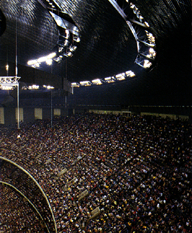 Bathed in light glaring from on high, colorfully
Bathed in light glaring from on high, colorfully
clad crowd packs the Superdome to enjoy a
football game.
If even the fans are trying to throw their weight around, it's hard to
imagine what the owners of professional teams are up to. Though getting
or keeping a team is usually the main reason cities build a dome, the
team's owner may pay as little rent as $1 a year. "The newer the deal,
the better the deal from the team's point of view," says Wallace. "And
every contract that's renegotiated will be improved in favor of the
team. It has to do with competition among cities, prestige and ego."
Nor does having a dome guarantee that a team will stay put.
The NBA Jazz left the Superdome and the Pistons are pulling out of the
Silverdome to build their own arena. The NFL Oilers threatened to leave
the Astrodome, but decided to remain when stadium authorities agreed to a
$60 million expansion. With more domes being built, the pressure to hold
on to teams by subsidizing them will increase. All this may make civic
leaders reluctant to gamble on a dome.
It will make them reluctant, that is, unless they happened to watch the
Metrodome in Minneapolis "steal" the World Series from the St. Louis
Cardinals last October. The Minnesota Twins won all of their home games
in large part, it is widely believed, because the Metrodome bottled up
and redoubled the roaring of their fans. A dismayed sports columnist in
Milwaukee worried that the first indoor Series was going to give people
the idea that "putting up a weird dome" might be one way to win a
championship. But maybe the uproar over the Metrodome Series was just
another instance of the hype that seems to be the natural element of
domed stadiums everywhere. Before his Bears played the Vikings in the
Metrodome, football coach Mike Ditka remarked sourly: "Indoor domes
should be used for roller rinks" - and then strapped on a pair of skates,
just to make his point.
In truth, all that a dome can really assure is a comfortable outing for
the fans, which is what 20,000 spectators enjoyed on a muggy Thursday
evening last July when Houston took on the Phillies at the Astrodome.
Inside, spotlights illuminated the steel fretwork of the dome, giving it
a 19th-century kind of charm. The crowd was almost subdued, which may
have been partly because of supervision exercised by the Astrodome staff.
("One sign read, 'We hate the Mets worse than Communism,' " recalls a
security man. "We made them take down everything except 'We hate the
Mets.' That's baseball.") Yet dome crowds do appear to be less
rowdy than a typical outdoor crowd. It has to do with the psychology of
being indoors, speculates an Astrodome executive. "My mom always said,
'You want to play, go outside. Don't be rambunctious in the house.' "
It is not a bad insight. Where television brought baseball into the
living room, the domes have brought the living room into the stadium.
Everybody's cool and relaxed. There's a big screen on the scoreboard in
case you missed a call. Freed of the distractions of weather and
rowdiness, a fan in a dome is able to concentrate on the game. That
particular evening in Houston last summer, a kid named Ken Caminiti,
appearing in his first major league game, made some outstanding plays at
third base for the Astros and took a swipe at the doom-dome legend with a
triple and a home run to right field. Baseball was still baseball, the
beer and franks tasted just fine, and after Caminiti walked and scored a
run in the ninth to give the Astros the game, 2 to 1, the crowd went home
happy.
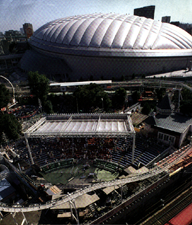 Scheduled to open this spring, multiuse dome in
Scheduled to open this spring, multiuse dome in
Tokyo dwarfs amusement park. It's called the Big Egg.
 Back to History Main Menu
Back to History Main Menu












 Back to History Main Menu
Back to History Main Menu